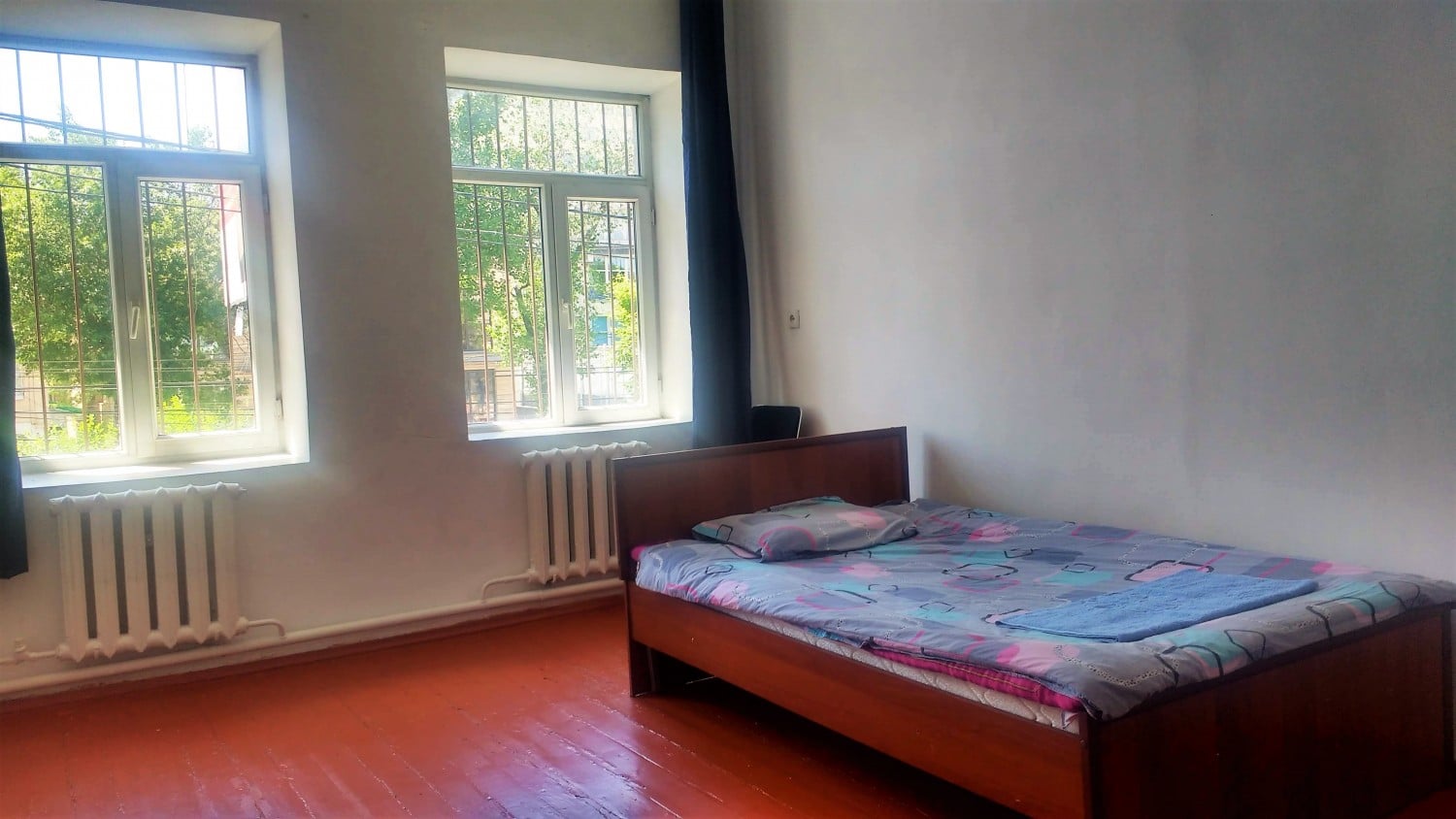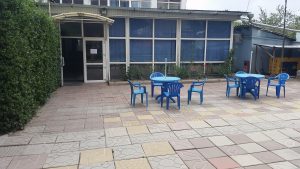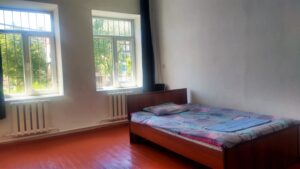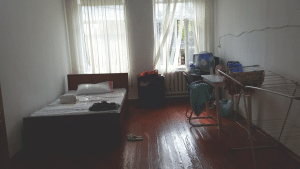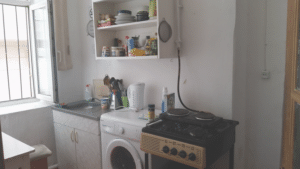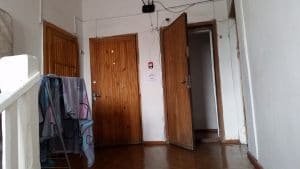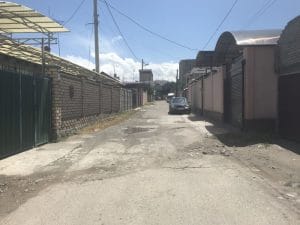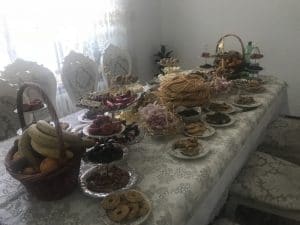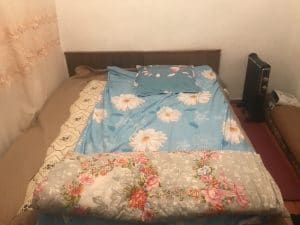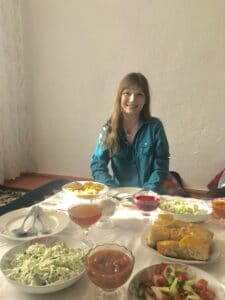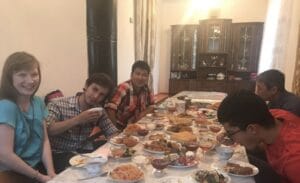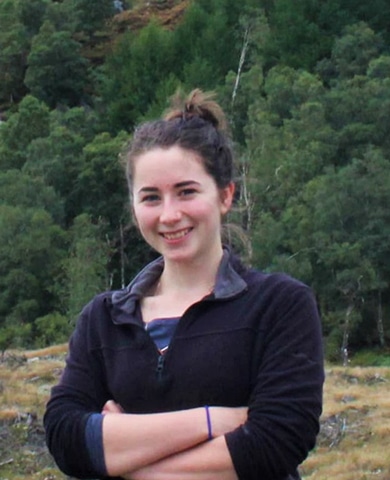In Bishkek, you have two living options: a home stay or a dormitory. Each comes with its own pros and cons. The following student reviews of the Bishkek domitories are meant to help you make your housing decision and prepare for your time abroad on SRAS programs in Bishkek.
Bishkek Dormitories
Living Conditions in the Bishkek Dormitories
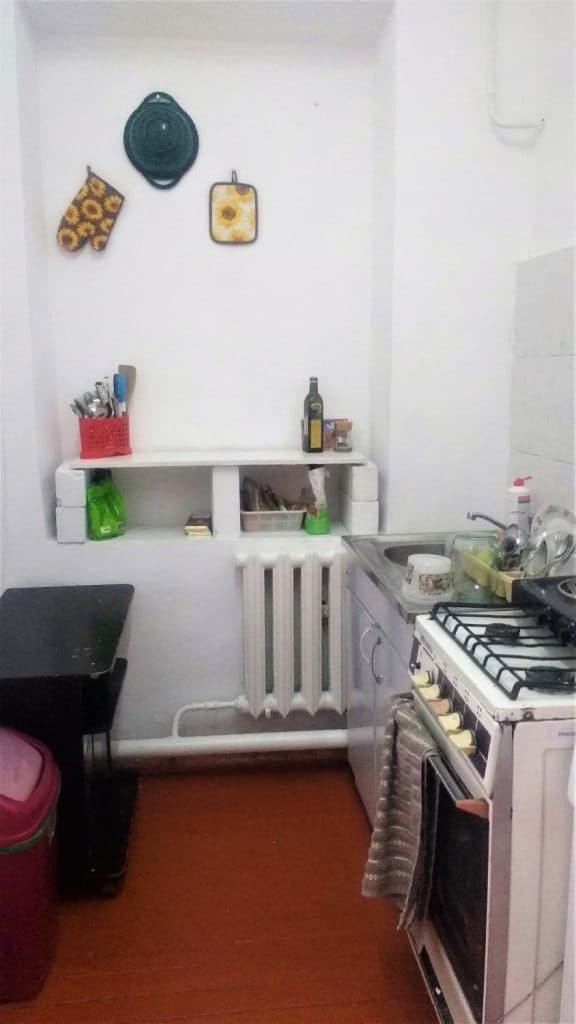
Kat Watt (Spring, 2019): I’m going to be real, London School dorms are hardly a five star hotel, but they have made some improvements recently. The dorms are located upstairs from the main London School complex and are divided into four soviet-style apartments. Each apartment has 2-3 bedrooms, a bathroom, and a kitchen. The bedrooms are medium to large and contain a bed, a desk, and storage space. The London School has recently repainted the apartments, modernized the lighting system, and installed curtains. As a result, they are bright and pleasant, despite being fairly basic.
The bathroom and kitchen situation has been known to cause culture shock to students and teachers living in the dorms. Most bathrooms have a bath, toilet, and sink (in one apartment there is a shower instead of a bath). They are functional, though a little disheveled in appearance – do not be surprised by random wires and pipes sticking out all over the place. Another thing to note is that toilet paper cannot be flushed down the toilet, but a bin is provided (this is actually fairly common globally). Every kitchen has a sink, washing machine, fridge, collection of dishes and cutlery, and hot plates for cooking. Some apartments have microwaves and hot-box style electric ovens – it is generally expected that students share appliances among themselves. Not every bathroom and kitchen has a window so ventilation can be an issue at times. If there is anything you need that you consider essential, it’s worth asking management – they will often buy new appliances upon request.
Daphne Letherer (Summer, 2018): There is always a security guard present on the grounds. The dorm is comprised of five suites, most of which have two private bedrooms, a bathroom, and a kitchen. One suite has three bedrooms and one suite is downstairs, between classrooms. The kitchens are functional, but by no means luxurious. In our kitchen, a hot plate sits on top of the non-functioning stove, and you can forget about using an oven because they are either absent or don’t work. Each kitchen has different things in it. My kitchen came loaded with utensils, so befriend the residents of Suite 5 if you want to cook. The suites also come with refrigerators. Some of the suites have full-sized refrigerators and the rest have half-sized ones. There are no microwaves, so we use the hot-plates to reheat food. The rooms only have 1-2 electrical outlets, so charging devices can be challenging. I brought a portable battery to charge my phone during the scheduled horse trek and excursions outside of the city, but because of the outlet situation it’s turned out to be useful in Bishkek, too — I use it frequently in my dorm. My room only has one outlet, and I usually have my fan plugged into it because of the oppressive summer heat, and so the portable battery allows me to both charge my phone and stay (somewhat) cool.
The dorm gets extremely hot in the summer. Every room should have a fan, which you will need to survive in the summer. If you don’t have one, contact the school right away. The school tells you to let them know if you need anything, but for issues that aren’t emergencies, responses are slow or nonexistent without persistence. For example, I asked for another set of sheets, and a friend asked for measuring cups. Neither of us received responses. It’s not a bad idea to bring your own towel or sheets. The staff are not responsible for cleaning the sheets between residents, so bring your own set or be prepared to do laundry when you arrive. Plus, a piece of home can add some comfort and contrast with the somewhat impersonal white walls. Don’t expect your bathroom to feel like home, either. The water pressure is finicky, and the tubs sit at odd heights. Regardless, it has everything you need.
There is a cleaning lady who comes each week, but that doesn’t mean you should leave all your dirty dishes for her to clean or your trash exploding everywhere (because the trash cans are very small). Doing your dishes and taking out your overflowing trash are not part of her job description. She also has keys to your room, and she goes inside it to mop the floor. To save both yourself and her some embarrassment, and to make sure your floor gets mopped, avoid leaving dirty clothes all over the floor.
Location of the Bishkek Dormitories
Kat Watt (Spring, 2019): The London School dorms have a fantastic location on a central road that leads straight into the city center. It is also great to be able to roll straight out of bed in the morning and walk downstairs to classes. There is a range of shops, restaurants, parks, and sports clubs within walking distance from the London School. There is also a bus stop nearby, though most students tend to share taxis as they are very cheap, especially when the price is split with a group. A disadvantage of the centralized location is that there is a lot of noise, air, and light pollution.
Daphne Letherer (Summer, 2018): Initially, I lived in the off-campus student house – the new London School dormitory annex. It is about 20 minutes from the school by marshrutka or a 35 minute walk. The house is great. It is quiet because it sits away from the road. There is a garden with flowers and an awning over the patio so you can sit outside in the shade. It also has a full kitchen, two bathrooms, and spacious bedrooms. However, the commute to school is tiring, and that is the reason I switched to the on-campus dorm, which is a part of the school building.
Social Life in the Bishkek Dormitories
Kat Watt (Spring, 2019): Generally speaking, the dorms are a very sociable place. Unfortunately there is no common room but nevertheless students tend to cook together, share appliances, and socialize in the kitchen areas. There is also a courtyard outside, which is a pleasant place to relax and eat, especially when the weather is nice.
All in all, though the dorms are nothing fancy, they are perfectly liveable and can easily be spruced up with some household plants and decorations. Beyond a doubt, the highest selling points are the location and sociable atmosphere.
Daphne Letherer (Summer, 2018): Despite the challenges, I love living in the dorms. I can wake up minutes before class and still make it in time. It’s also easy to roll out of bed and grab breakfast at the cafeteria — not to mention that Vefa Center is a stone’s throw away. Vefa has a grocery store, clothing stores, and restaurants. One of the best things about staying on campus is how easily you can meet up with the other students on the program. Making plans to go out is easy, and you can bond over cooking in the sparse kitchen. The dorm is much closer to Ala-Too Square than is the student house, as well, so eating out at a restaurant, finding a new café, or going for a walk in the park isn’t a hassle. Best of all, I made my closest friends here by moving into the dorm. I spent every evening with someone who became one of my best friends for life because we were a stone’s throw away from each other. While the dorm wasn’t the most glamorous place to live, I wouldn’t have exchanged it for anything in Bishkek.
Bonus: A Guide to Cooking in the Dorms
By Daphne Letherer
When I signed up to live in the dorms, I was prepared to live on a diet of peanut butter and jelly sandwiches and eggs. I was not encouraged to stray from this plan when I saw that the kitchen boasted only a hot plate in place of a stove and had no oven for heating frozen meals. However, I befriended Allie, who lived across the hall, and she was ready to cook. She had been in Bishkek for three weeks before I arrived, so for her the glamour of eating out every night had worn off. The problem was that neither of us knew how to cook. My experience ended at fried eggs and heating up corn dogs in the oven. Although we were intimidated, we made a list of simple dishes that we could make without an oven. Then we hit the Frunze Grocery Store in the nearby Vefa shopping center. We overcame our fear of handling raw meat and can now chop vegetables with relative ease, thanks in part to a borscht cooking class held by the London School.
Quick tips:
- Allie’s mom made her pack Norton’s Nature’s Seasonings when she left for Bishkek, and it was lifesaving. We used it on everything we cooked because Frunze doesn’t stock herbs like basil or oregano.
- There is no marinara sauce here for pasta — only tomato paste. (You can achieve a more sauce-like consistency by adding water to tomato paste.)
- Frunze has boneless chicken and ground beef.
- We found tortillas at the Bishkek Supermarket, which was a 15-minute walk from the school to the south.
- You’ll notice a common theme in the recipes below: using carrots, peppers, and onions. Vefa doesn’t have celery, and the former three vegetables go well with many meals while giving you the vitamins and minerals that will be missing from the cafeteria lunches.
- Whenever one of the recipes calls for veggies: If applicable, peel the vegetable, then cut it in half a few times before chopping it as finely or coarsely as you like. Scoop the seeds out of the peppers.
- Soups are very easy and make a lot of leftovers that are easily reheated. Tacos, spaghetti, or quesadillas are simple alternatives for when it’s too hot for soup.
- Finally, purchase cling wrap to save your leftovers!
During my five weeks in the dorm, we made the following:
Stir Fry
Ingredients: rice, peppers, carrots, onions, broccoli, peas, soy sauce or teriyaki sauce, boneless chicken, chicken bouillon
1. Cut up the chicken and chop the vegetables.
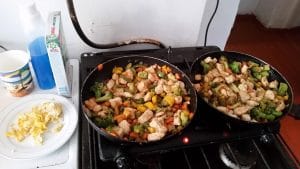
2. Fry the chicken and vegetables together until chicken is cooked and veggies are soft. (If you’re intimidated by the raw chicken, you can boil the chicken separately and add it to the veggies and rice at the end.)
3. If you’re making stir fry with rice, boil the rice in a separate pot while you fry the vegetables and chicken.
4. When everything is cooked and soft, combine the rice with the chicken and vegetables. Then add teriyaki or soy sauce.
When we made stir fry with rice and soy sauce, it could’ve used another spice for flavor, and the rice didn’t reheat very well. The next time we made stir fry, the teriyaki sauce was more flavorful, and it kept better without rice.
Chicken noodle soup
Ingredients: boneless chicken, bouillon, carrots, onions, noodles
1. Cut up the chicken into cubes and boil it separately because it takes a long time for the large pot to heat up on the hot plate, and to avoid the risk of having raw chicken in the finished soup.
2. Chop the vegetables and add to a pot with water.
3. Add bouillon to the vegetables, which should boil until they are soft.
4. When the vegetables are soft, add the cooked chicken. Also throw in some Nature’s Seasonings (or another seasoning) to add flavor.
5. Let the chicken and vegetables simmer together for about 20 minutes.
The soup, despite the Nature’s Seasonings, was a little plain, but was much better as leftovers after all the ingredients had time to sit together.
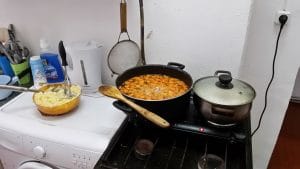
Mashed Potatoes
We had a potato masher, so we decided to make mashed potatoes to pair with the chicken-noodle soup.
Ingredients: potatoes, garlic, bouillon, butter
1. Boil the potatoes with some bouillon (we used the leftover chicken water from making the chicken noodle soup).
2. Add raw garlic after mashing the potatoes. We had a potato masher (which is why we decided to make mashed potatoes to pair with the chicken noodle soup), otherwise mashing the potatoes will probably take a long time.
They could’ve used another spice, but with plenty of butter and Nature’s Seasonings, the mashed potatoes and soup were a sweet taste of home.
Tacos
Ingredients: ground beef, red pepper seasoning mix, tortillas (actually shawarma wraps, found at Bishkek Supermarket), tomato, lettuce, cheese, cilantro, onion, sour cream
1. Fry the beef with onions. When the beef is cooked, add the seasoning and water so that the bottom is covered.
2. Let that simmer, drain it, and you’re ready for Taco Tuesday.
The tortillas we found were very brittle, so they had to be torn and then made into mini tacos.
Vegetable and Beef Soup
Ingredients: ground beef, tomato paste, beef bouillon, carrots, onion, peppers, corn, potatoes
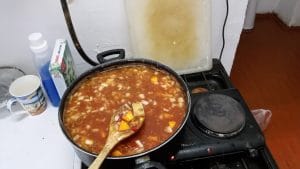
1. Fry the beef.
2. While you fry the beef, chop the vegetables however finely you’d like. Put the veggies in a pot with water, bouillon, and tomato paste.
3. After you add in the fried beef, let it cook on high heat for an hour, or until the potatoes are soft. It’s delicious and can provide lots of leftovers.
Salad
Ingredients: lettuce, carrots, peppers, Italian dressing
Just rinse the veggies and chop them up to make an easy side salad. It’d be easy to add cooked chicken to make it an entrée. I found Italian dressing at Vefa, but it did not taste like Italian dressing in the US because mushrooms were a primary ingredient.
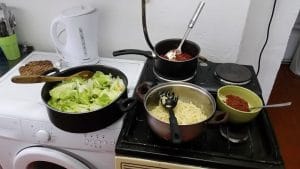
Spaghetti (with meat sauce)
Spaghetti is a favorite dish among students in the dorm. However, you can make it much better and more filling by adding ground beef to the sauce and a packet of spaghetti seasoning. We also added chopped, raw garlic to the sauce to give it more flavor.
Ingredients: noodles, tomato paste, spaghetti seasoning (packet of seasonings for soups and other dishes, called “Maggi для Макарон в томатно-мясном соусе болонез), ground beef, garlic
1. Fry the beef.
2. Heat up tomato paste in a small pot (don’t forget to add water to the tomato paste to make it thinner!)
3. When the beef is cooked all the way through, add it to the saucepan.
4. Add spaghetti seasoning packet and chopped garlic to sauce.
5. Boil the noodles and drain when soft.
Pancakes and Eggs
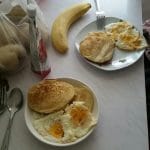
Your mealtimes in Bishkek don’t have to consist of nothing but plain pasta or eating out every night. Grab a friend and look up easy meals to make without an oven, and you’ll be eating well while you’re in Bishkek! Allie and I had no cooking experience before coming to Kyrgyzstan, and now we easily whip up hearty meals that last us for a few days. We’ll now return home with improved Russian and the ability to cook.
Homestays in Bishkek
In Bishkek, you have two living options: a home stay or a dormitory. Each comes with its own pros and cons. The following student reviews of Bishkek homestays are meant to help you make your housing decision and prepare for your time abroad on SRAS programs in Bishkek.
Home stays with SRAS programs in Bishkek are anywhere from 15-50 minutes commute from class, but this commute itself can provide an opportunity for learning. More than in other SRAS locations, host families in Bishkek are larger, with more children and, at times, extended family living under one roof, meaning you have more extensive opportunities for language practice and cultural interaction.
Bishkek Homestay as a Vegan (Summer, 2019)
By Kathryn Watt
Wondering about staying with a local family while you’re in Bishkek? Though every family is different, hopefully my experience will give a glimpse into what to expect. As a vegan, I’d also like to share my experience abroad to help other vegans better prepare for their homestays.
The House
It was early morning when I arrived at my homestay and I was greeted my host mum with a hug and a kiss on each cheek. Entering the surprisingly Western style kitchen, I was given a bowl of chickpea soup and encouraged to take some bread. Bread is a very important part of the culture here! Next, I was shown my room and given a tour of the house. It was very spacious and modern, with two fully plumbed bathrooms and a swimming pool in the front yard. My room was large and minimalistic. There was a bed, a chest of drawers, a desk with a seat, and bedside shelves. I was also provided with two sets of bed sheets and a towel. Downstairs was the kitchenette, a comfortable living room with a TV, and what I can only describe as “the banqueting room.” In one corner stood a piano and, stretching out across the room, was a long dining table, lined with fancy chairs. As a little nod to their nomadic past, a sad looking wolf skin hung on the wall. Not quite a vegan’s dream.
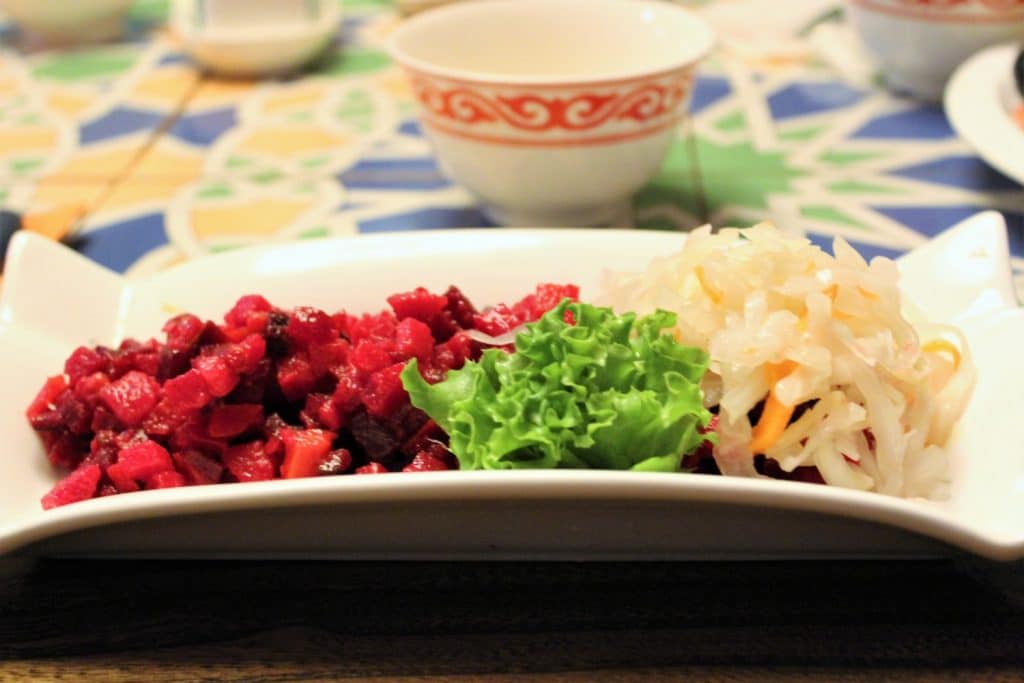
Food
Honestly, I struggled with the food at times. I grew up in a Central Asian country so had an idea of what kind of food to expect, but having gone vegan a year ago, I knew that the food may be a challenge while staying with a local family. While vegetarianism and veganism have made inroads into post-Soviet countries, they remain often misunderstood. My advice is to nail your colors to the mast from day one. I made the mistake of accepting food that had been cooked in animal fat the first week, out of feeling awkward and not wanting to make a fuss. However, it is much easier to say from the start exactly what you are okay with eating, rather than changing your boundaries halfway through your time. Clear communication is key and as you are paying for a service as well as a room, it is okay to request food that comes in line with your dietary requirements. There are ways of going about this diplomatically and you can ask London School representatives to be the middle person if need be. Try to be gracious with your host family as they are getting used to the different way that you do things just as much as you are getting used to them.
Despite my veganism, I was still able to try some modified versions of authentic Kyrgyz food! As an avid cook, I loved learning how to make delicious treats such as chak chak, lagman, and manti. Cooking with my host sister was also a fun and practical way to learn new vocabulary.
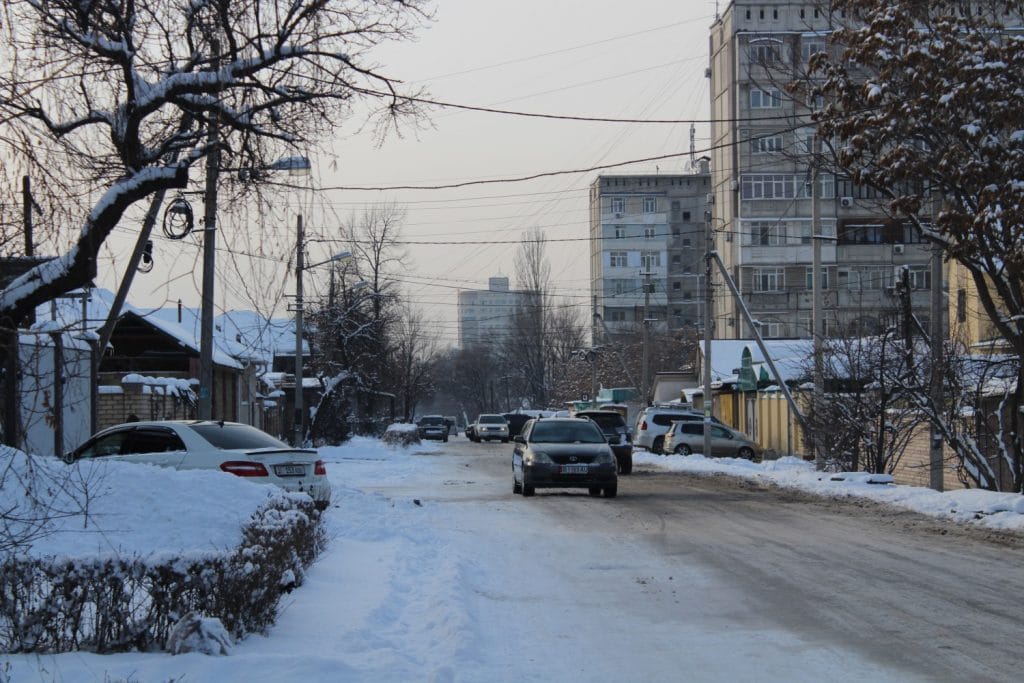
Culture
The family spoke a mixture of Russian and Kyrgyz, as is the case with most local families in Bishkek. This was good as it meant that I could take part in the Russian parts of conversations, while being able to rest my mind when the language switched to Kyrgyz. Of course, the most important thing to be gained from a homestay is the language and cultural aspect. No matter how much a language is studied, and a culture read about, nothing can replicate experiencing it for yourself. Staying with a family, I had the opportunity to get completely immersed in Russian language and have real life conversations about things that I cared about, rather than learning purely from a course curriculum. What’s more, I had the chance to experience life here like a local. One such experience was a trip to the banya with my host sister.
It was a Wednesday afternoon and I was ready for a relaxing (and cheap!) spa experience. When we entered the banya, we had our shoes switched for flip flops and proceeded to the locker room to change. I soon realized that “changing” meant “undressing”, after being told off by a spa attendant for wearing a swimming costume. Though I had been to a banya in Russia, it had been at a private dacha so the British side of me still cringed at the idea of a nude public spa. Soon enough, I got over myself and enjoyed the experience, but it was certainly a big cultural difference!
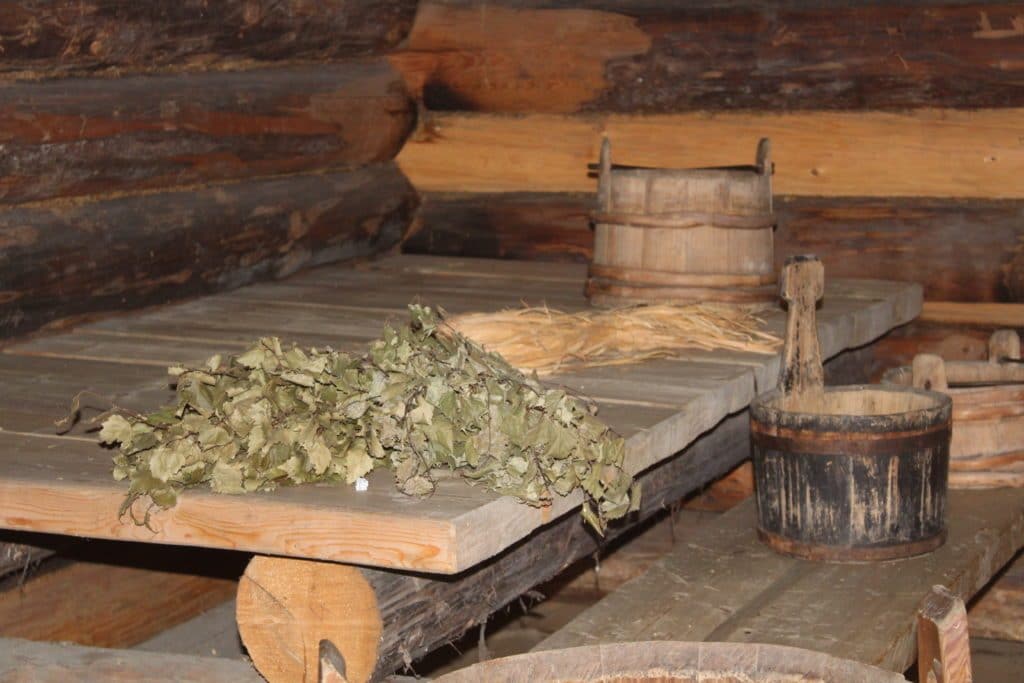
Conclusion
Overall, my host family were very hospitable, warm, and relaxed people. Though I had expected my freedom to be limited by staying with a family, this wasn’t the case at all. I was given my own key so could come and go when I pleased. I also had full access to use the kitchen for cooking and baking whenever I liked. All in all, it was lovely to have the balance of staying in a comfortable family home while living an independent life.
Pros
- Excellent for full language immersion.
- An opportunity to try authentic local food.
- An immediate gateway to meeting other locals and making friends out with the expatriate circle.
- The chance to find out the best things to see and do from a local’s perspective.
Cons
- Food – dietary requirements will often be misunderstood and potentially not taken seriously due to cultural differences. Food is also very fatty and sugary.
- Possible lack of independence (depending on the family).
- Potentially a long commute to London School.
- Tiredness – staying with a host family is tiring as you need to deal with cultural differences and speaking in a different language most of the time.
Bishkek Homestay and Talas Trip Homestay (Summer, 2018)
by Kathleen Connell
Bishkek
I decided to stay with a local host family in Bishkek to improve my Russian communication skills. My host family has four members, all of whom live on the west side of town. My hosts include the father, mother, their 11-year-old son, and an uncle. Their daughter is currently studying abroad in England, so I did not have a chance to meet her.
We first met over tea, where we introduced ourselves and chatted about our respective family histories, interests and life experiences. I brought some gifts to thank them for hosting me. These gifts included an assortment of Latin American foods, ranging from spices, Mexican chocolate, and Colombian guava paste. I chose to give these gifts because it is rather difficult to find anything Latin American in Kyrgyzstan and I wanted to introduce one of the many cultures that make up American identities.
My host family provides breakfast and dinner. For lunch, I normally eat at Cooksoo, a Korean restaurant located a few buildings away from the London School in Bishkek. My homestay dinners typically include Lagman (a Central Asian noodle dish) and a meat-and-potato stir-fry. For breakfast, I have bread, butter, and jam, with a bowl of oatmeal or cottage cheese on the side. I have my own set of keys, which allows me to leave and return home at any time of day.
All in all, I really like my host family. They have a beautiful home with a garden blooming with fragrant roses and lilies. The food is delicious. Whenever I need help going somewhere, my host family is there to show me around the city. I am very glad to have chosen a homestay, because this host family has really contributed to my experience, and has improved my spoken Russian, as well as introduced me to many facets of Kyrgyz culture. I would never have learned as much as I have about Kyrgyz culture if it wasn’t for my host family. I am very thankful for their time, patience, and kindness with me during my summer abroad. I am now able to communicate in Russian more effectively than ever for every day I am greeted by my host family as well as asked to discuss my plans for the day with them.
Talas
I took a couple of weekend trips away from Bishkek to see the Kyrgyz countryside. One weekend excursion was to the town of Talas for a homestay with a local Kyrgyz family. Upon arriving in Talas, we were greeted and given some time to rest after the long drive from Bishkek. We then had a nice dinner with plov, a Central Asian rice dish, and fresh salads. Our host family offered tea and various Russian candies as quickly as our traveling group could eat them up.
Our host family was very nice and considerate of our well-being. Our hosts provided a delicious breakfast, after which we departed to see Manas Ordo, the main sight in Talas, before heading back to Bishkek. All in all, this homestay experience in Talas helped round out my cultural immersion experiences in Kyrgyzstan by living with a family in the city than having a weekend homestay in the countryside. I have learned so much already about Kyrgyz culture as well as how life, language, and culture differs in the city and countryside. This was certainly an experience that I could never forget.

